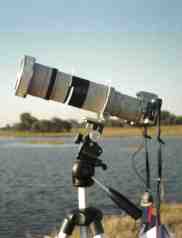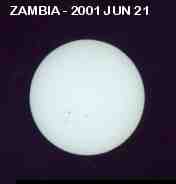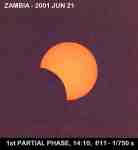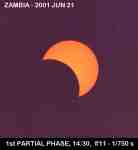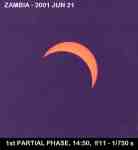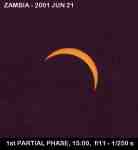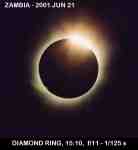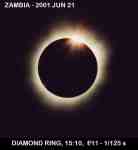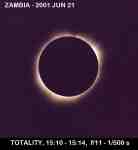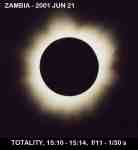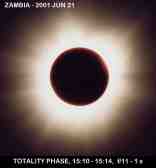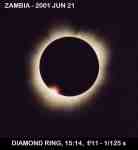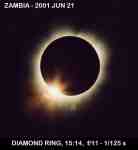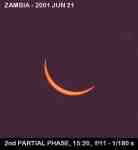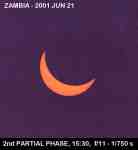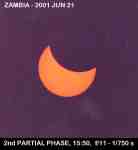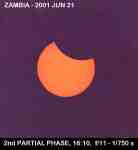This first total solar eclipse of
new millennium has crossed the southern Atlantic ocean north of Saint Helena
island and the Southern Africa continent with a totality path up to 200 km
width at a speed up to 1000 km/h and more, to end in the Indian Ocean. On
the African continent totality started in Angola at 12:39 GMT then crossed
Zambia, Zimbabwe and Mozambique and south of Madagascar.
June is quite a favourable period being during the tropical winter and dry
season with good probability of clear sky especially on the highlands. Angola
has the best weather forecast but the still endemic civil war discounts a
large influx of tourists, Zambia is the best alternative with his capital
city, Lusaka, the only big town within the path of totality. In Zambia eclipse
day has been declared national holiday as historical memories are associated
with this phenomenon. During an earlier solar eclipse, in 1835, the Ngoni
tribe (one of the over 70 different tribes in Zambia) crossed the Zambesi
River when they fled the warriors of the Zulu king Shaka. So this eclipse
provides the opportunity for local celebrations. Zambia, two times the size
of Italy and a population of 10 million, has a large number of national parks
with a spectacular wildlife almost ignored by western tourists.
The country is expecting 20000 foreign visitors for this occasion.
Karubwe Farm, located at center line 40 km north of Lusaka, has been chosen
as observation site. The geographical co-ordinates of the site measured by
GPS are the following: Latitude: 15° 08' 09" S
Longitude: 28° 27' 26" E
The eclipse local times are approximately the same as for Lusaka
International Airport: Beginning of partial eclipse (B.P.E.): 13:42
Beginning of total eclipse (B.T.E.): 15:10
End of total eclipse (E.T.E.): 15:14
End of partial eclipse (E.P.E.): 16:28
and the duration of totality is 3' 35".
